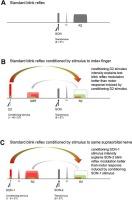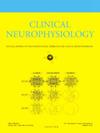The sensory input, not the motor output, defines blink reflex conditioning
IF 3.7
3区 医学
Q1 CLINICAL NEUROLOGY
引用次数: 0
Abstract
Objective
Blink reflexes following supraorbital nerve (SON) stimulation are typically modulated by conditioning stimuli (CS) to the index finger (D2) (low-intensity, prepulse inhibition paradigm) or SON (same intensity, paired-pulse paradigm). We aimed to disentangle whether CS-intensity or CS-induced motor responses define blink reflex modulation.
Methods
In 35 subjects, test SON stimuli (8 times sensory threshold, 8 × ST) were applied either alone or following CS. In experiment 1, CS were delivered to D2 with low (2 × ST) or high intensity (inducing a somatosensory blink reflex). In experiment 2, CS were applied to SON with low (<2 × ST) or test intensity. Test blink reflex size was correlated to CS-intensity and to CS-induced motor response size. Relative strength of their influence was determined in regression analyses.
Results
Test blink reflex size showed higher inverse correlation to CS-intensity than to CS-induced motor response size for both CS delivered to D2 or SON. Regression analyses confirmed a significantly higher relative strength of CS-intensity than of CS-induced motor response size.
Conclusions
The sensory input of CS, rather than CS-induced motor output, defines subsequent blink reflex modulation.
Significance
This ubiquitous phenomenon calls for caution when relating the size of test responses to the size of conditioning responses particularly in paired-pulse paradigms.

决定眨眼反射调节的是感觉输入,而不是运动输出
目的 刺激眶上神经(SON)后的眨眼反射通常会受到食指(D2)(低强度、预脉冲抑制范式)或SON(相同强度、配对脉冲范式)的条件刺激(CS)的调节。我们的目的是区分是CS强度还是CS诱导的运动反应决定了眨眼反射的调节。方法在35名受试者中,单独或在CS之后施加测试SON刺激(8倍感觉阈值,8 × ST)。实验 1 中,在 D2 处施加低强度(2 × ST)或高强度(诱发体感眨眼反射)的 CS。在实验 2 中,CS 以低强度(<2 × ST)或测试强度作用于 SON。测试眨眼反射的大小与 CS 强度和 CS 诱导的运动反应大小相关。结果无论是对 D2 还是对 SON 施加 CS,测试眨眼反射大小与 CS 强度的反相关性都高于 CS 诱导的运动反应大小。回归分析证实 CS 强度的相对强度明显高于 CS 诱导的运动反应大小。结论 CS 的感觉输入而非 CS 诱导的运动输出决定了随后的眨眼反射调节。
本文章由计算机程序翻译,如有差异,请以英文原文为准。
求助全文
约1分钟内获得全文
求助全文
来源期刊

Clinical Neurophysiology
医学-临床神经学
CiteScore
8.70
自引率
6.40%
发文量
932
审稿时长
59 days
期刊介绍:
As of January 1999, The journal Electroencephalography and Clinical Neurophysiology, and its two sections Electromyography and Motor Control and Evoked Potentials have amalgamated to become this journal - Clinical Neurophysiology.
Clinical Neurophysiology is the official journal of the International Federation of Clinical Neurophysiology, the Brazilian Society of Clinical Neurophysiology, the Czech Society of Clinical Neurophysiology, the Italian Clinical Neurophysiology Society and the International Society of Intraoperative Neurophysiology.The journal is dedicated to fostering research and disseminating information on all aspects of both normal and abnormal functioning of the nervous system. The key aim of the publication is to disseminate scholarly reports on the pathophysiology underlying diseases of the central and peripheral nervous system of human patients. Clinical trials that use neurophysiological measures to document change are encouraged, as are manuscripts reporting data on integrated neuroimaging of central nervous function including, but not limited to, functional MRI, MEG, EEG, PET and other neuroimaging modalities.
 求助内容:
求助内容: 应助结果提醒方式:
应助结果提醒方式:


